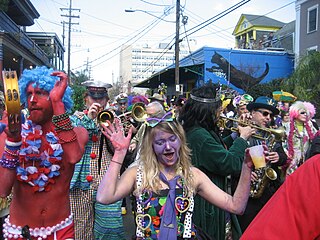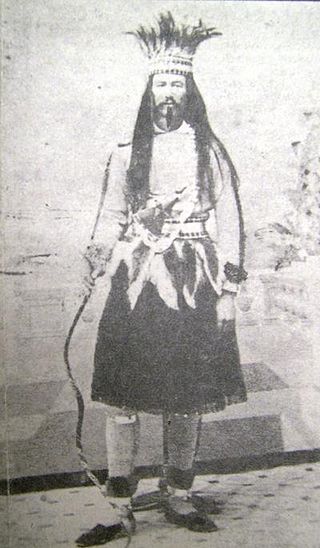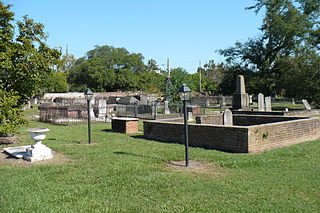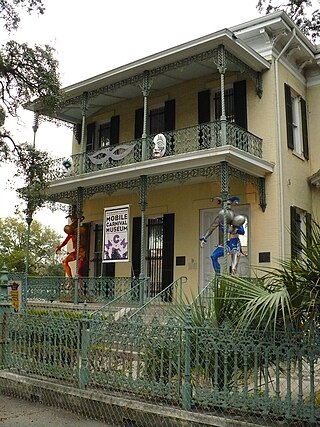
Mobile is a city and the county seat of Mobile County, Alabama, United States. The population within the city limits was 187,041 at the 2020 census, down from 195,111 at the 2010 census. After a successful vote to annex areas west of the city limits in July 2023, Mobile's population increased to 204,689 residents. It is now the second-most-populous city in Alabama, after Huntsville.

Mardi Gras refers to events of the Carnival celebration, beginning on or after the Christian feasts of the Epiphany and culminating on the day before Ash Wednesday, which is known as Shrove Tuesday. Mardi Gras is French for "Fat Tuesday", reflecting the practice of the last night of eating rich, fatty foods before the ritual Lenten sacrifices and fasting of the Lenten season.

The Sydney Gay and Lesbian Mardi Gras or Sydney Mardi Gras is an event in Sydney, New South Wales attended by hundreds of thousands of people from around Australia and overseas. One of the largest such festivals in the world, Mardi Gras is the largest Pride event in Oceania. It includes a variety of events such as the Sydney Mardi Gras Parade and Party, Bondi Beach Drag Races, Harbour Party, the academic discussion panel Queer Thinking, Mardi Gras Film Festival, as well as Fair Day, which attracts 70,000 people to Victoria Park, Sydney.

Prichard is a city in Mobile County, Alabama, United States. As of the 2020 census, the population of the city was 19,322, down from 22,659 at the 2010 census. Prichard borders the north side of Mobile, as well as the Mobile suburbs of Chickasaw, Saraland, and the unincorporated sections of Eight Mile.

Downtown Los Angeles (DTLA) contains the central business district of Los Angeles. In addition, it contains a diverse residential area of some 85,000 people, and covers 5.84 sq mi (15.1 km2). A 2013 study found that the district is home to over 500,000 jobs. It is also part of Central Los Angeles.

Joseph Stillwell Cain, Jr. is largely credited with initiating the modern way of observing Mardi Gras and its celebrations in Mobile, Alabama, following the Civil War. In 1868, while Mobile was still under Union occupation, Joe Cain paraded through the streets of Mobile, dressed in improvised costume as a fictional "Chickasaw" chief named Slacabamorinico. The choice was an attempt to insult to U.S. Army forces in that it was believed by some that the Chickasaw tribe had never been defeated in war. Joe was joined at some point by six other Confederate veterans, parading in a decorated coal wagon, playing drums and horns, and the group became the "L. C. Minstrel Band", now commonly referred to as the "Lost Cause Minstrels" of Mobile.

The Daphne Civic Center is a multipurpose convention and performing arts center located in Daphne, Alabama, United States. The Center features 11,931 square feet (1,108 m2) of exhibit and meeting space in the main exhibit hall, which also features a 37-by-70-foot permanent stage. For concerts, the exhibit hall can seat 1,700; for banquets, 900; receptions, 1,247; and in a classroom setup, 676. The exhibit hall's arched roof rises up to 24 feet (7 m).

Reston Town Center is a mixed-use urban development featuring offices, apartments, retail stores, and restaurants in Reston, Virginia owned and managed primarily by Boston Properties.

Semmes is a city in western Mobile County, Alabama, in the Mobile metropolitan area. It was incorporated in 2011. As of the 2020 census, the population was 4,941.

Mardi Gras is the annual Carnival celebration in Mobile, Alabama. It is the oldest official Carnival celebration in the United States, started by Frenchman Nicholas Langlois in 1703 when Mobile was the capital of Louisiana. Although today New Orleans and South Louisiana celebrations are much more widely known for all the current traditions such as masked balls, parades, floats and throws were first created there. From Mobile being the first capital of French Louisiana (1702), the festival began as a French Catholic tradition. Mardi Gras has now evolved into a mainstream multi-week celebration across the spectrum of cultures, becoming school holidays for the final Monday and Tuesday, regardless of religious affiliation.

Regions Field is the name of a minor league baseball park in the Southside community of Birmingham, Alabama, U.S. It is the home field for the Birmingham Barons of the Southern League, and replaced Hoover Metropolitan Stadium in the Birmingham suburb of Hoover as their home field. It also serves as the second home field along with Jerry D. Young Memorial Field for the UAB Blazers. Regions Field is located adjacent to the Railroad Park, just south of downtown Birmingham.

Bienville Square is a historic city park in the center of downtown Mobile, Alabama. Bienville Square was named for Mobile's founder, Jean-Baptiste Le Moyne, Sieur de Bienville. It takes up the entire block bordered by the streets of Dauphin, Saint Joseph, Saint Francis, and North Conception.

Church Street Graveyard is a historic city cemetery located in Mobile, Alabama. The cemetery is situated on 4 acres (1.6 ha) and is surrounded by a brick wall that dates to 1830. At the time that the cemetery was established it lay about a half mile away from most development, but it is now considered to be in downtown.

A mystic society is a Mardi Gras social organization in Mobile, Alabama, that presents parades and/or balls for the enjoyment of its members, guests, and the public. The New Orleans Krewe is patterned after Mobile's Mystics. The societies have been based in class, economic and racial groups. Mobile's parading mystic societies build colorful Carnival floats and create costumes around each year's themes.

The Mobile Carnival Museum is a history museum that chronicles over 300 years of Carnival and Mardi Gras in Mobile, Alabama. The museum is housed in the historic Bernstein-Bush mansion on Government Street in downtown Mobile.

Mardi Gras in the United States is not observed nationally across the country, largely due to the country's Protestant and Anglo-Saxon roots. Mardi Gras and Carnival are mostly Catholic holidays, while the United States has a Protestant-majority population. However, a number of cities and regions in the U.S. have notable Mardi Gras or Carnival celebrations. Most of these places trace their Mardi Gras celebrations to French, Spanish, and other Catholic colonial influences on the settlements over their history. The earliest Carnival celebration in North America occurred at a place on the west bank of the Mississippi River about 60 miles (97 km) downriver from where New Orleans is today; this Mardi Gras on March 3, 1699, and in honor of this holiday, Pierre Le Moyne, Sieur d'Iberville, a 38-year-old French Canadian, named the spot Point du Mardi Gras near Fort Jackson. The earliest organized Carnival celebrations occurred in Mobile, then the capitol of French Louisiana known as Fort Louis de la Mobile, where in 1704 the first known Carnival secret society. In 1856, six Mobile natives established the first secret society, or krewe, in New Orleans, the Mistick Krewe of Comus. Former French and Spanish colonies such as Pensacola, Biloxi, and settlements along the Gulf Coast all followed suit in incorporating Carnival into their annual celebrations, which today have developed either separate traditions or variations of them from one another. In addition, modern activities generally vary from city to city across the U.S.
The Gulf Coast Limited was a passenger train service operated by Amtrak along the Gulf Coast of the United States. It ran daily between New Orleans, Louisiana, and Mobile, Alabama, with stops in Bay St. Louis, Gulfport, Biloxi, and Pascagoula, Mississippi. The route first operated in 1984–1985, and again in 1996–1997.

The state of Alabama has invested in aerospace, education, health care, banking, and various heavy industries, including automobile manufacturing, mineral extraction, steel production and fabrication. By 2006, crop and animal production in Alabama was valued at $1.5 billion. In contrast to the primarily agricultural economy of the previous century, this was only about 1% of the state's gross domestic product. The number of private farms has declined at a steady rate since the 1960s, as land has been sold to developers, timber companies, and large farming conglomerates.

The Intergalactic Krewe of Chewbacchus is a science fiction–themed Mardi Gras krewe, religious and parade organization, that also features fantasy and horror groups, among other fandoms. Based in New Orleans, Louisiana, as of the 2019 parade, the Intergalactic Krewe of Chewbacchus has over 2500 dues-paying members who call themselves "ChewbacchanALIENs" or "Chewbs."
The following is a timeline of the history of the city of Mobile, Alabama, USA.





















